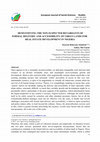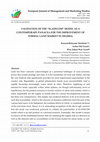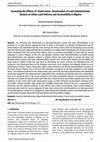Papers by Kazeem Bolayemi AKINBOLA

European Journal of Economic and Financial Research, 2017
The centrality of land to man's socioeconomic and even political survival, has long been recognis... more The centrality of land to man's socioeconomic and even political survival, has long been recognised as a non-negotiable necessity. Apparently, because of the relative fixity of this resource, coupled with ever soaring demographic bursts, that had made it imperative more than ever before, to ensure the management, administration, control and regulation of its use and development a top priority. However, it must be frankly admitted, that formal land market, which is driven by the dynamics of supply and demand, which are otherwise termed delivery and accessibility respectively, are faced with very unimaginable challenges of unprecedented scales. Although, these 'brickwalls' are emanating from very many different contexts, but arguably, the most copious of them are traceable to formal land administration and regulation systems. Therefore, it is in a bid to address this very unfortunate trending turbulence, created and sustained by 'brickwalls' of formal land administration and regulation system, as reflected above, that this study was conducted. Hence, subsequent upon literature search that revealed some salient issues, that was evidenced to be brickwalls of land administration and regulation system. Therefore, structured questionnaires were designed with 5point Likert scale format and distributed via purposive and convenience sampling technique, among 450 respondents that were adopted for the sample size, from a sample frame 850 respondents, out of the total sample space of 2408 i

European Journal of Social Science Studies, 2017
There appears to be a constantly incontrovertible, yet delicately inseparable cord, between land ... more There appears to be a constantly incontrovertible, yet delicately inseparable cord, between land resource as an all-time invaluable asset, and meaningful socioeconomic growth and development. Much as this assertion holds, what enigmatically remains almost unsolvable is the seeming unending mystery that surrounds 'wilful' prevention of access to this very non-substitutable resource, in spite of its tangentiality to virtually all endeavours, around which the survival of all human beings revolves. Thence, it is compellingly tempting to reason that, some 'unseen' factors are decidedly making the delivery and accessibility of land, especially within urban milieu, extremely difficult, so much that, enviable growth and development might be so perennially elusive, particularly to the poor segment of the populace, which unfortunately forms the largest proportion of any country's citizenry, Nigeria inclusive. Although, the trend facades itself to be solely caused by economic and other attendant pecuniary factors, but as all the economically-defined strategies seem not too effective over the years, to finally nail several challenges associated with formal land delivery and accessibility; it behoves upon researchers and policy-makers alike, to look beyond the ordinary. Hence, the demystification exercise such as this, which is geared towards unravelling this mystery, reveals more factors that are indeed non-pecuniary, this is the crux of this study.

International journal of research and innovation in social science, Dec 31, 2022
The importance of housing as a social good has made it a frequent subject matter of discussion in... more The importance of housing as a social good has made it a frequent subject matter of discussion in both developed and developing nations, where it continues to be accorded great attention. Due to cities' unchecked and widespread urban growth, there is housing scarcity problem in many cities around the world, particularly in developing countries, such as Nigeria. Nigeria housing problem is not just quantitative in nature but also qualitative and unaffordability. Governments at various levels have introduced numerous housing scheme that is geared towards supplying housing and bridging housing gap, however, majority of these housing schemes are still beyond the reach of the low income earners in terms of affordability. Hence, this study assessed the affordability of Lagos State government social housing scheme through the Lagos state rent-to-own-scheme. The study revealed that the housing units are costly and not affordable to lowmedium income earners as 2bedroom and 3-bedroom flats are priced at N20,000,000.00 and N25,000,000.00 and above respectively. An applicant of a 2-bedroom flat is expected to pay an initial equity capital of N1, 000,000.00 and N1, 250,000.00 for a 3-bedroom flat, while the residue of the cost is payable for a period of 10years on monthly basis (N158, 333.3 and N197, 916.00 monthly repayment respectively). This is disheartening and appalling social housing scheme as it is not affordable and within the reach of most Nigerians using house price to income ratio as a threshold for measuring affordability It is therefore recommended that government should adopts affordable housing delivery strategies such as cost saving design approach, promotion of local building materials, vertical housing development, mass housing that incorporate sustainable strategies; recycling of building materials for reuse, while also increasing the repayment period from 10years to 15years. When these approaches are adopted, it will aid affordability and integrate low-medium income earners in the social housing scheme

Land has been variously acknowledged as a perennial harbinger of socio-economic power that exudes... more Land has been variously acknowledged as a perennial harbinger of socio-economic power that exudes prestige and class. It is the foundation for food and shelter, driving the very bedrock that significantly provides for most employment opportunities in the country side. Regrettably, as global urbanisation trends soars uncontrollably, land is rapidly becoming increasingly scarce assets in cities. Therefore, supplying of and demand for lands, especially within urban spheres, are though unfortunately never at equilibrium, but the present scenarios in formal window of urban land market, which is solely responsible for the supply of formal land for various developmental purposes, has been very unimpressive. This simply, has rendered delivery to be at its lowest ebb, such that accessibility, which is the measure of demand coefficients from the part of the various land users, to be hampered, the resultant effects of which is consistent decrease of the real estate stock. Hence, it is in astou...
Advanced Science Letters, 2018

Land as a factor of real estate production is though freely given by nature, but its relative fix... more Land as a factor of real estate production is though freely given by nature, but its relative fixity and associated scarcity, coupled with unprecedented demographical increase, has made it one of the singly-costliest resources in history. It is quite unfortunate that formal route of accessing developable lands by teeming population of Nigerians is fast becoming a mirage, as the need continually arises that citizens tend to look for alternative way(s) of getting their land requirements met. However, it is in a bid to unravel and demystify some of the undercurrent issues that surround the poor formal accessibility of lands, especially within urban milieu, together with myriads of daunting challenges, that calls for torch-lighting some of the factors responsible for this very ugly scenario. Therefore, it is against the above background, that this research was conducted, by evolving 2 sets of structured questionnaires, totalling 80 and were distributed among land administrators and regu...

European journal of social sciences, 2017
There appears to be a constantly incontrovertible, yet delicately inseparable cord, between land ... more There appears to be a constantly incontrovertible, yet delicately inseparable cord, between land resource as an all-time invaluable asset, and meaningful socio-economic growth and development. Much as this assertion holds, what enigmatically remains almost unsolvable is the seeming unending mystery that surrounds ‘wilful’ prevention of access to this very non-substitutable resource, in spite of its tangentiality to virtually all endeavours, around which the survival of all human beings revolves. Thence, it is compellingly tempting to reason that, some ‘unseen’ factors are decidedly making the delivery and accessibility of land, especially within urban milieu, extremely difficult, so much that, enviable growth and development might be so perennially elusive, particularly to the poor segment of the populace, which unfortunately forms the largest proportion of any country’s citizenry, Nigeria inclusive. Although, the trend facades itself to be solely caused by economic and other attend...

Path of Science, 2016
The efficiency and effectiveness of land administration system had been acknowledged to be premis... more The efficiency and effectiveness of land administration system had been acknowledged to be premised on so many factors, arguably the chief of which, is the degree of mutuality, frictionlessness and bidirectionality in the interrelationship that exist amongst the various factors that are discharging arrays of tasks that these formal lands regulo-administrative machineries are saddled with. Undoubtedly, this simple conduct of affairs resultantly drives the formal lands delivery, hence it increases accessibility to urban lands by several categories of users in Nigeria, as thus the case globally. However, these interrelationships are absent among land administration and regulation systems in Nigeria. Hence, this study intends to assess the direct and possible indirect impacts that these interrelationships fallouts have on the formal delivery and accessibility of urban lands in Nigeria, Firstly, this was done by articulating the issues involved and calibrating them into constructs, then measuring them via the following scorecards , thus: myopism, non-ingenuity, disservice, ecofinancial loss, distrust, trauma, anti-growth, death, market distortion and thriving informalisation focussing on the South Western Nigeria. Out of the total 586 individuals considered as the total population for the sample space, 120 individual qualified for the sample frame, upon which the structured questionnaires were distributed among land regulators, land administrators, independent land consultants and ultimate land users, essentially to have a fair and broad view of the issues inherent in this lands accessibility dilemma. 93 questionnaires were retrieved, out of which 87 questionnaires were valid, thus formed the basis upon which analyses were done, with emphasis on the 5 point Likert scale measurement usage, via both inferential and descriptive statistical tools. The results showed amongst other things, that unbridled relationship frictions had led to unwarranted role jettisoning and this impacts adversely on the delivery pace which concomitantly warps formal pathway to accessing urban lands by various categories of land users. Among the recommendations are that government formal land agencies should be re-configured to build synergy that engenders positive interrelationship and role synchronisation towards improved formal land delivery and accessibility in Nigeria.

The responses of government, public, researchers and professionals alike could have been boosted ... more The responses of government, public, researchers and professionals alike could have been boosted in need to tenaciously tackle residential neighborhood crime if there were enough research and publication on the diverse consequences of residential neighborhood crime. The main objective of this article is to critically evaluate the consequences of residential neighborhood crime. The research finding revealed a triangular nature of the consequences in that it burdens on the property and its environs; on government and its agencies and thirdly on the residents. This study believes that tackling residential neighborhood crime portends some benefits like the removal of fear of crime which will inferably boost residents’ health status towards efficiency of labour, boost housing investment, increase government revenue from property tax and in turn reduce public spending on crime control. All these efforts would translate to environmental sustainability. Article visualizations:

Indian Journal of Science and Technology, 2016
Objectives: To evaluate SLADECOM (Synergised Land Administration and Development Compliance Model... more Objectives: To evaluate SLADECOM (Synergised Land Administration and Development Compliance Model) as a proposed model, to amplify the strengths and remove the weaknesses of Nigeria’s land administration systems, with a view to buoying them for improved performance. Methods/Statistical Analysis: This model’s latitude was calibrated to 10 constructs of 30 queries and gauged against the following benchmarks: Environmental acceptability, demographic suitability, contemporary robustness, administrative consistency, regulatory sufficiency, histo-futuristic connectedness, effective resourcefulness, practical applicability, contextual relevance and technical versatility. Hence, integrity checks showed that 91 retrieved questionnaires out of the 100 structured questionnaires that were administered, using purposive and simple random sampling among all stakeholders in land administration system within the southwest Nigeria, 86 were properly filled and thus were considered valid for analyses, using 5 point Likert scale of measurement admixtured with averages from simple descriptive and inferential statistical tools. Findings: The results showed among other things that, SLADECOM model has sufficient strength to accommodate past, present and emerging requirements associated with increasing complexities of formal land delivery by Nigeria’s land administration systems (79.85% agreed+strongly agreed). Also, it is well positioned to tackle varieties of needs of increasingly land driven endeavours of Nigerians as the population continue to soar (79.89% agreed+strong agreed). Applications/Improvement: Among this model’s numerous relevance, is by directly applying it to synergise the present stand-alone structure of Nigeria’s land administration system and reconfigure them for greater efficiency and effectiveness. Nigeria’s government should endeavour to imbibe a culture of regular system overhauling, dynamic restructuring and role refinement as essentials for continual robust structure that engenders improved performance of land administration machineries, so as to facilitate formal delivery and increase accessibility of urban lands in Nigeria.
SSRN Electronic Journal, 2000
Kazeem Bolayemi AKINBOLA and Azlina Md YASSIN by Kazeem Bolayemi AKINBOLA

Uploads
Papers by Kazeem Bolayemi AKINBOLA
Kazeem Bolayemi AKINBOLA and Azlina Md YASSIN by Kazeem Bolayemi AKINBOLA